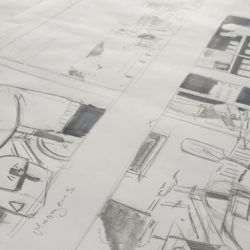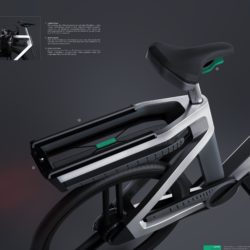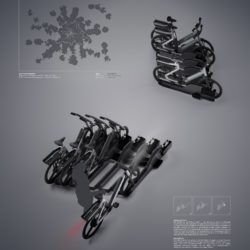sane
Description
sane is the result of a design process specifically aimed at developing mobility solutions. Transport research, spatial-structural analyses and the recording of user needs are combined and translated into concrete mobility requirements. This basis enabled the targeted design of sane, a newly conceived e-bike sharing concept that connects commuters in suburban areas to the public transport system and takes over local mobility tasks.What is the Topic?
Commuters in suburban and regional areas often have no alternative but to use the car to get to work. They are therefore considered to be one of the causes of inner-city traffic problems and represent one of the greatest challenges for the turnaround in transport. The aim of sane was to offer commuters a demand-oriented alternative to the car for commuting to work that is suitable for everyday life. Against this background, an e-bike service was developed which provides residents in suburban areas with low-threshold access to rail transport. sane provides impulses for the relevance of design in mobility planning and actively contributes to harmonising living conditions between city, suburban and rural areas.
Why does it look like this?
The concept is divided thematically into two main areas of design. The space-saving storage of pedelecs at railway stations required detailed coordination of the service infrastructure with the vehicle, which has an impact on the design of the fork, handlebars and luggage rack, for example. The adaptation to the context of use and the broad target group of commuters* themselves created the framework for the universal dimensioning and feature requirements of the pedelec. In terms of form aesthetics, the pedelec is characterised by a clear, understated surface design. Sensitive components have been integrated into the frame in a protective manner and communicate its status as a service product.
What is special?
sane shows a way how "New Mobility" can also reach commuters* on the periphery and what consequences this has on the product and service level. The connection with other mobility offers plays a major role, the importance of which was emphasised by the design of an optimised interface to rail transport. Conceptually, the service is based on the cyclical commuter movements, which enables the service infrastructure at stations to be bundled. The maintenance and recharging of pedelecs is combined with regular commuting to work. The pedelecs spend the night in the care of the users* and are at their free disposal until they are handed over to a mobility hub. The users* thus have a vested interest in maintaining the vehicles, which reduces the risk of vandalism. With this principle of shared use, large areas can be made accessible by only one mobility hub at the station. In addition to its function as a feeder to the public transport system, the features of the pedelec also provide support in tasks of local mobility, e.g. shopping, transporting children to day-care centres or the evening trip to yoga. The concept is to be understood as a building block of a mobility network consisting of several interlocking solutions.
What is new?
Networked mobility does not only take place in digital space. Convincing solutions are always an interplay of digital and product innovations. sane was created in a design process based on the combination of traffic research, user* needs and area-specific factors, which were then translated into a mobility service. The work is intended to stimulate reflection on the relevance of design in the planning and implementation of a traffic turnaround beyond the automobile.




